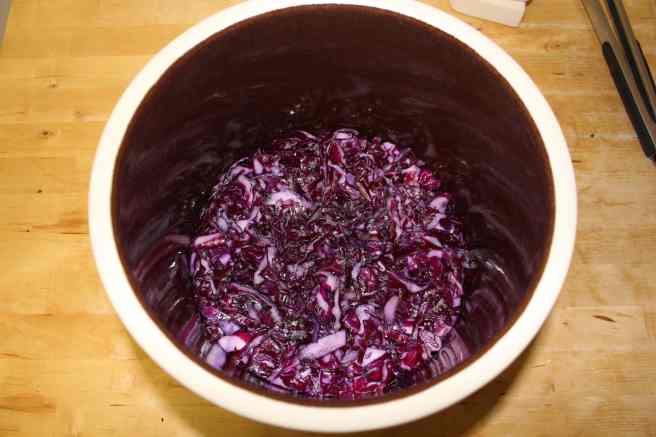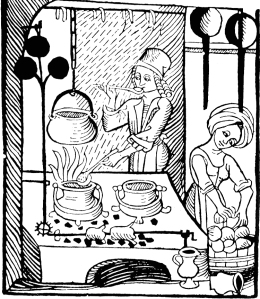 Last summer I tried to make sauerkraut – and failed. Which is why I hadn’t written about it so far. When I present something on here, I want to be certain the recipe works and the writing and the photos are as good as they can be given the time and technology I have at my disposal. This post is going to be different. No one needs yet another recipe for fermenting cabbage. There are plenty of fantastic resources on the internet already. Instead, I’ll report from my new fermenting project, as I’m trying out a new crock, a new recipe and, incidentally, also my new DSLR camera. The project might succeed or it might fail…
Last summer I tried to make sauerkraut – and failed. Which is why I hadn’t written about it so far. When I present something on here, I want to be certain the recipe works and the writing and the photos are as good as they can be given the time and technology I have at my disposal. This post is going to be different. No one needs yet another recipe for fermenting cabbage. There are plenty of fantastic resources on the internet already. Instead, I’ll report from my new fermenting project, as I’m trying out a new crock, a new recipe and, incidentally, also my new DSLR camera. The project might succeed or it might fail…
Day 2:
Admittedly, I’m checking the progress of the kraut every morning and night – at least. First observation – the brine turned a dark violet from the cabbage. It’s very pretty.
Flavor: Unchanged, but I’m starting to wonder if it’s too salty.
Color: The brine is turning into a really nice violet.
Texture: Unchanged, but air bubbles are starting to raise from under the stones.
Photo: Aperture priority mode with flash – aperture 3.5, shutter speed 1/30, ISO 2000. I’m in the market for a tripod, so I can take shots without flash.

Day 0:
Everything starts with a great crock and I got a really nice one for my birthday – woohooo! It’s an Ohio Stoneware crock without a water lock, which made me slightly nervous after reading some ardent supporters of water locks. But I calmed down after consulting the fermenting book by Sandor Ellix Katz. I first encountered him on an episode of the Gravy Podcast a couple of months ago, which inspired me to return to fermenting.

So after a day of dissertation writing, I turned to this project to take my mind off of research and do something with my hands. I chopped up two heads of cabbage. Red cabbage, because that seemed more fun. As the kraut turns more acidic, it should turn in color from bluish violet to a brighter red. (You may remember this from my red cabbage basics post.)
I weighed it and added kosher salt (51 grams of salt per 5 lb of cabbage. I had 4.4 pounds, but I’m excellent at rule of three. Katz says to do it by feeling, but that’s just not me. I like precise measurements – for now.) I mashed everything for a bit with my hands and a potato masher, but, man, that cabbage is tough. Not much juice formed, even after packing it tightly into the crock, weighing it down with the fermenting weights and waiting for a couple of hours. So I added two more cups of brine, until the weights were under water, covered it with a towel and the lid and now I’m waiting.

First evaluation…
Flavor: Salty cabbage flavor. Quite sharp actually – as raw cabbage tends to be.
Color: Dark blue, still with a lot of white.
Texture: Crunchy – this was good fresh cabbage. (Organic from Whole Foods. 99cts per head – I hadn’t realized how cheap cabbage is…)
Photo: Full automatic setting with flash that yielded: shutter 1/60, aperture 4.0, ISO 800. As was to be expected, food in artificial light + flash looks quite awful. One of the challenges of working on blog stuff at night is that it’s always dark, when it’s time to take the pictures… Any ideas how to solve this problem?

If you can’t take photos in daylight I would say put the food under the brightest light you have and take a photo without a flash.
LikeLiked by 1 person
Yeah, but even the brightest light isn’t that bright. I just really need a tripod…
LikeLike